
Concept explainers
(a)
Interpretation:
The IUPAC name of given compound is to be stated.
Concept introduction:
Carboxylic acids are the carbon compounds that contain carboxyl group as a major
The chemical structures are described by IUPAC name or common names. IUPAC names are totally different from common names because IUPAC names are applied at international level and it comprises suffix, prefix, numbers and other priority rules.
(a)
Answer to Problem 20.25SP
The
Explanation of Solution
The chemical structure of the given compound is shown in figure 1.

Figure 1
The structure comprises chain of five carbon atoms along with
Therefore, the
(b)
Interpretation:
The IUPAC name of given compound is to be stated.
Concept introduction:
Carboxylic acids are the carbon compounds that contain carboxyl group as a major functional group. These are polar compounds due to difference in an electronegativity of the atoms in a compound.
The chemical structures are described by IUPAC name or common names. IUPAC names are totally different from common names because IUPAC names are applied at international level and it comprises suffix, prefix, numbers and other priority rules.
(b)
Answer to Problem 20.25SP
The
Explanation of Solution
The chemical structure of the given compound is shown in figure 2.
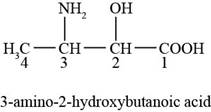
Figure 2
The structure comprises chain of four carbon atoms along with carboxylic acid group, hydroxyl group and amino group at first, second, and third carbon atoms respectively. Carboxylic acid group gets higher priority during the naming of structure because it is present at first carbon atom. According to
Therefore, the
(c)
Interpretation:
The IUPAC name of given compound is to be stated.
Concept introduction:
Carboxylic acids are the carbon compounds that contain carboxyl group as a major functional group. These are polar compounds due to difference in an electronegativity of the atoms in a compound.
The chemical structures are described by IUPAC name or common names. IUPAC names are totally different from common names because IUPAC names are applied at international level and it comprises suffix, prefix, numbers and other priority rules.
(c)
Answer to Problem 20.25SP
The
Explanation of Solution
The chemical structure of the given compound is shown in figure 3.
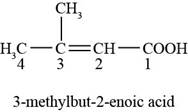
Figure 3
The structure comprises chain of four carbon atoms along with carboxylic acid group and methyl group at first and third carbon atoms respectively. The double bond is present in between the second and third carbon atoms. Carboxylic acid group gets higher priority during the naming of structure because it is present at first carbon atom. According to
Therefore, the
(d)
Interpretation:
The IUPAC name of given compound is to be stated.
Concept introduction:
Carboxylic acids are the carbon compounds that contain carboxyl group as a major functional group. These are polar compounds due to difference in an electronegativity of the atoms in a compound.
The chemical structures are described by IUPAC name or common names. IUPAC names are totally different from common names because IUPAC names are applied at international level and it comprises suffix, prefix, numbers and other priority rules.
(d)
Answer to Problem 20.25SP
The
Explanation of Solution
The chemical structure of the given compound is shown in figure 4.
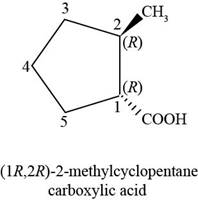
Figure 4
The structure comprises cyclic ring of five carbon atoms along with one group of carboxylic acids at first carbon atom and one methyl group at second carbon atom. The carboxylic acid group is present below the plane, whereas methyl group is present at above the plane. According to
Therefore, the
(e)
Interpretation:
The IUPAC name of given compound is to be stated.
Concept introduction:
Carboxylic acids are the carbon compounds that contain carboxyl group as a major functional group. These are polar compounds due to difference in electronegativity of the atoms in a compound.
The chemical structures are described by IUPAC name or common names. IUPAC names are totally different from common names because IUPAC names are applied at international level and it comprises suffix, prefix, numbers and other priority rules.
(e)
Answer to Problem 20.25SP
The
Explanation of Solution
The chemical structure of the given compound is shown in figure 5.
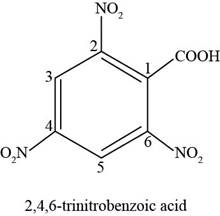
Figure 5
The structure comprises cyclic ring of six carbon atoms along with one carboxylic acid group at first position and three nitro groups at second, fourth and sixth carbon atoms. According to
Therefore, the
(f)
Interpretation:
The IUPAC name of given compound is to be stated.
Concept introduction:
Carboxylic acids are the carbon compounds that contain carboxyl group as a major functional group. These are polar compounds due to difference in electronegativity of the atoms in a compound.
The chemical structures are described by IUPAC name or common names. IUPAC names are totally different from common names because IUPAC names are applied at international level and it comprises suffix, prefix, numbers and other priority rules.
(f)
Answer to Problem 20.25SP
The
Explanation of Solution
The chemical structure of the given compound is shown in figure 6.
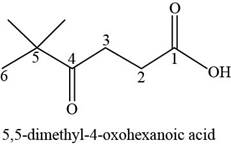
Figure 6
The structure comprises parent chain of six carbon atoms along with carboxylic acid group, carbonyl group, and two methyl groups at first, fourth and fifth carbon atoms respectively. According to
Therefore, the
Want to see more full solutions like this?
Chapter 20 Solutions
Organic Chemistry Plus Masteringchemistry With Pearson Etext, Global Edition
- true or false, given that a 20.00 mL sample of NaOH took 24.15 mL of 0.141 M HCI to reach the endpoint in a titration, the concentration of the NaOH is 1.17 M.arrow_forwardin the bromothymol blue experiment, pKa was measured. A closely related compound has a Ka of 2.10 x 10-5. What is the pKa?a) 7.1b) 4.7c) 2.0arrow_forwardcalculate the equilibrium concentration of H2 given that K= 0.017 at a constant temperature for this reaction. The inital concentration of HBr is 0.050 M.2HBr(g) ↔ H2(g) + Br2(g)a) 4.48 x 10-2 M b) 5.17 x 10-3 Mc) 1.03 x 10-2 Md) 1.70 x 10-2 Marrow_forward
- true or falsegiven these two equilibria with their equilibrium constants:H2(g) + CI2(l) ↔ 2HCI(g) K= 0.006 CI2(l) ↔ CI2(g) K= 0.30The equilibrium contstant for the following reaction is 1.8H2(g) + CI2 ↔ 2HCI(g)arrow_forwardI2(g) + CI2(g) ↔ 2ICIK for this reaction is 81.9. Find the equilibrium concentration of I2 if the inital concentration of I2 and CI2 are 0.010 Marrow_forwardtrue or false,the equilibrium constant for this reaction is 0.50.PCI5(g) ↔ PCI3(g) + CI2(g)Based on the above, the equilibrium constant for the following reaction is 0.25.2PCI5(g) ↔. 2PCI3(g) + 2CI2(g)arrow_forward
- true or false, using the following equilibrium, if carbon dioxide is added the equilibrium will shift toward the productsC(s) + CO2(g) ↔ 2CO(g)arrow_forward2S2O2/3- (aq) + I2 (aq) ---> S4O2/6- (aq) +2I- (aq) Experiment I2 (M) S2O3- (M) Initital Rate (M/s) 1 0.01 0.01 0.0004 2 0.01 0.02 0.0004 3 0.02 0.01 0.0008 Calculate the overall order for this reaction using the table data a) 3b) 0c) 2d) 1arrow_forwardthe decomposition of N2O5 is the first order with a half-life of 1.98 minutes. If the inital concentration of N2O5 is 0.200 M, what is the concentration after 6 minutes?a) 0.612 Mb) 0.035 Mc) 0.024 Md) 0.100 Marrow_forward
- 20.00 mL of 0.150 M HCI is titrated with 0.075 M NaOH. What volume of NaOH is needed?a) 50 mLb) 20 mLc) 40 mLd) 26.66 mLarrow_forward20.00 mL of 0.150 M NaOH is titrated with 37.75 mL of HCI. What is the molarity of the HCI?a) 0.150 Mb) 0.079 Mc) 0.025 Md) 0.050 Marrow_forwardin the following reaction, the OH- acts as which of these?NO2- (aq) + H2O (l) ⇌ OH- (aq) + HNO2 (aq)a) not a weak acidb) basec) acidarrow_forward
- Chemistry: Matter and ChangeChemistryISBN:9780078746376Author:Dinah Zike, Laurel Dingrando, Nicholas Hainen, Cheryl WistromPublisher:Glencoe/McGraw-Hill School Pub Co
 Chemistry & Chemical ReactivityChemistryISBN:9781337399074Author:John C. Kotz, Paul M. Treichel, John Townsend, David TreichelPublisher:Cengage Learning
Chemistry & Chemical ReactivityChemistryISBN:9781337399074Author:John C. Kotz, Paul M. Treichel, John Townsend, David TreichelPublisher:Cengage Learning Chemistry & Chemical ReactivityChemistryISBN:9781133949640Author:John C. Kotz, Paul M. Treichel, John Townsend, David TreichelPublisher:Cengage Learning
Chemistry & Chemical ReactivityChemistryISBN:9781133949640Author:John C. Kotz, Paul M. Treichel, John Townsend, David TreichelPublisher:Cengage Learning  Introductory Chemistry: A FoundationChemistryISBN:9781337399425Author:Steven S. Zumdahl, Donald J. DeCostePublisher:Cengage Learning
Introductory Chemistry: A FoundationChemistryISBN:9781337399425Author:Steven S. Zumdahl, Donald J. DeCostePublisher:Cengage Learning



